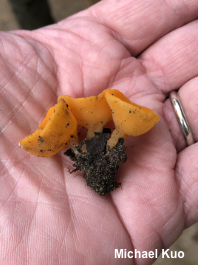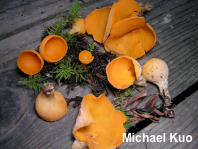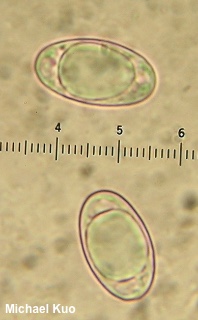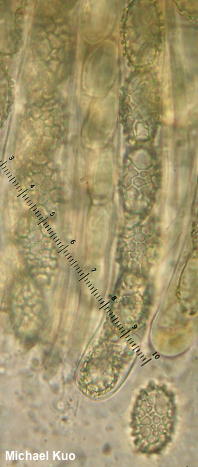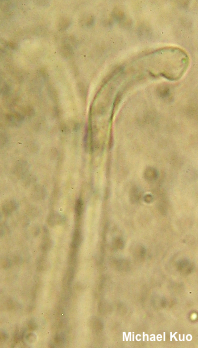| Major Groups > Cup Fungi > Sowerbyella rhenana |

|
Sowerbyella rhenana [ Ascomycota > Pezizales > Pyronemataceae > Sowerbyella . . . ] by Michael Kuo This little cup fungus has a well-developed stem and a smooth, bright orange upper surface. The stem and under surface are initially pale orange to whitish, but with age become colored more or less like the upper surface of the cup. Under the microscope Sowerbyella rhenana has gorgeous, coarsely reticulate spores, along with paraphyses that are sometimes bent or "hooked" like those in the genus Otidea. Sowerbyella rhenana is often treated as a species of Aleuria ("Aleuria rhenana"), since it shares many features found in that genus, including the bright colors and the ornamented spores. But Moravic (1986) argued that the species was better placed in Sowerbyella, and DNA evidence (Perry and collaborators, 2007) supports the idea. Description: Ecology: Probably mycorrhizal (Tedersoo et al. 2010), growing gregariously or in loose clusters on the ground, usually in conifer woods; summer and fall, or over winter on the West Coast; apparently widely distributed in North America but more common in the west. The illustrated and described collections are from California and Michigan. Fruiting Body: Cup-shaped, with a stem. Cups 18–25 mm across; upper surface bald, bright orange; under surface bald, pale orange; stem 10–25 x 3–5 mm, whitish to pale orange and downy when young, becoming orange and more or less bald; flesh orangish, not changing when sliced, brittle. Odor: Not distinctive. Microscopic Features: Spores 18–22 x 10–12 µm; ellipsoid; smooth when immature, becoming ornamented with a thick, coarse reticulation; hyaline and uniguttulate in KOH; orangish golden in Melzer's. Asci 275–300 x 15–20 µm; 8-spored; hyaline in KOH; tips inamyloid. Paraphyses exceeding the asci by 5–10 µm; 3–6 µm wide; cylindric with apices subclavate to clavate (occasionally with slightly irregular swellings), straight or hooked 45–90 degrees; septate; smooth; hyaline in KOH. REFERENCES: (Fuckel, 1870) J. Moravec, 1986. (Seaver, 1928; Moravec, 1985; Arora, 1986; Moravec, 1988; Barron, 1999; McNeil, 2006; Medel et al., 2006; Yao & Spooner, 2006; Perry et al., 2007; Trudell & Ammirati, 2009; Tedersoo et al., 2010; Desjardin, Wood & Stevens, 2015; Siegel & Schwarz, 2016; Læssøe & Petersen, 2019.) Herb. Kuo 09281904. This site contains no information about the edibility or toxicity of mushrooms. |
© MushroomExpert.Com |
|
Cite this page as: Kuo, M. (2019, December). Sowerbyella rhenana. Retrieved from the MushroomExpert.Com Web site: http://www.mushroomexpert.com/sowerbyella_rhenana.html. |
